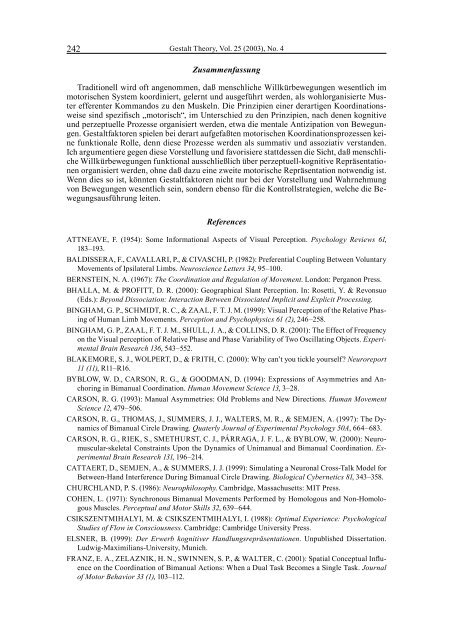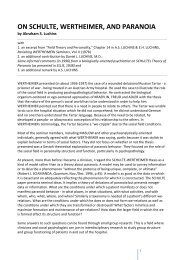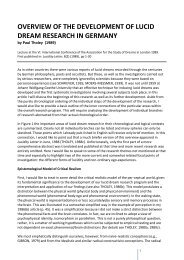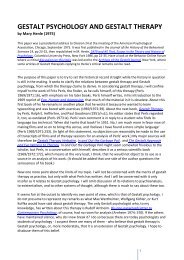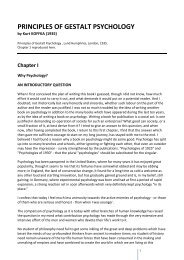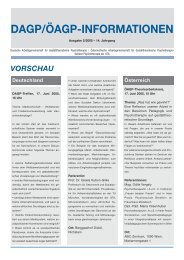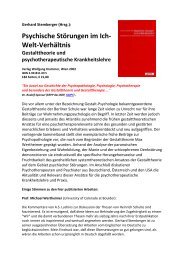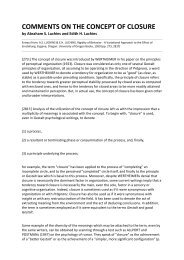Gestalt Factors in Human Movement Coordination - Society for ...
Gestalt Factors in Human Movement Coordination - Society for ...
Gestalt Factors in Human Movement Coordination - Society for ...
Create successful ePaper yourself
Turn your PDF publications into a flip-book with our unique Google optimized e-Paper software.
242<strong>Gestalt</strong> Theory, Vol. 25 (2003), No. 4ZusammenfassungTraditionell wird oft angenommen, daß menschliche Willkürbewegungen wesentlich immotorischen System koord<strong>in</strong>iert, gelernt und ausgeführt werden, als wohlorganisierte Musterefferenter Kommandos zu den Muskeln. Die Pr<strong>in</strong>zipien e<strong>in</strong>er derartigen Koord<strong>in</strong>ationsweises<strong>in</strong>d spezifisch „motorisch“, im Unterschied zu den Pr<strong>in</strong>zipien, nach denen kognitiveund perzeptuelle Prozesse organisiert werden, etwa die mentale Antizipation von Bewegungen.<strong>Gestalt</strong>faktoren spielen bei derart aufgefaßten motorischen Koord<strong>in</strong>ationsprozessen ke<strong>in</strong>efunktionale Rolle, denn diese Prozesse werden als summativ und assoziativ verstanden.Ich argumentiere gegen diese Vorstellung und favorisiere stattdessen die Sicht, daß menschlicheWillkürbewegungen funktional ausschließlich über perzeptuell-kognitive Repräsentationenorganisiert werden, ohne daß dazu e<strong>in</strong>e zweite motorische Repräsentation notwendig ist.Wenn dies so ist, könnten <strong>Gestalt</strong>faktoren nicht nur bei der Vorstellung und Wahrnehmungvon Bewegungen wesentlich se<strong>in</strong>, sondern ebenso für die Kontrollstrategien, welche die Bewegungsausführungleiten.ReferencesATTNEAVE, F. (1954): Some In<strong>for</strong>mational Aspects of Visual Perception. Psychology Reviews 61,183–193.BALDISSERA, F., CAVALLARI, P., & CIVASCHI, P. (1982): Preferential Coupl<strong>in</strong>g Between Voluntary<strong>Movement</strong>s of Ipsilateral Limbs. Neuroscience Letters 34, 95–100.BERNSTEIN, N. A. (1967): The Coord<strong>in</strong>ation and Regulation of <strong>Movement</strong>. London: Perganon Press.BHALLA, M. & PROFITT, D. R. (2000): Geographical Slant Perception. In: Rosetti, Y. & Revonsuo(Eds.): Beyond Dissociation: Interaction Between Dissociated Implicit and Explicit Process<strong>in</strong>g.BINGHAM, G. P., SCHMIDT, R. C., & ZAAL, F. T. J. M. (1999): Visual Perception of the Relative Phas<strong>in</strong>gof <strong>Human</strong> Limb <strong>Movement</strong>s. Perception and Psychophysics 61 (2), 246–258.BINGHAM, G. P., ZAAL, F. T. J. M., SHULL, J. A., & COLLINS, D. R. (2001): The Effect of Frequencyon the Visual perception of Relative Phase and Phase Variability of Two Oscillat<strong>in</strong>g Objects. ExperimentalBra<strong>in</strong> Research 136, 543–552.BLAKEMORE, S. J., WOLPERT, D., & FRITH, C. (2000): Why can’t you tickle yourself? Neuroreport11 (11), R11–R16.BYBLOW, W. D., CARSON, R. G., & GOODMAN, D. (1994): Expressions of Asymmetries and Anchor<strong>in</strong>g<strong>in</strong> Bimanual Coord<strong>in</strong>ation. <strong>Human</strong> <strong>Movement</strong> Science 13, 3–28.CARSON, R. G. (1993): Manual Asymmetries: Old Problems and New Directions. <strong>Human</strong> <strong>Movement</strong>Science 12, 479–506.CARSON, R. G., THOMAS, J., SUMMERS, J. J., WALTERS, M. R., & SEMJEN, A. (1997): The Dynamicsof Bimanual Circle Draw<strong>in</strong>g. Quaterly Journal of Experimental Psychology 50A, 664–683.CARSON, R. G., RIEK, S., SMETHURST, C. J., PÁRRAGA, J. F. L., & BYBLOW, W. (2000): Neuromuscular-skeletalConstra<strong>in</strong>ts Upon the Dynamics of Unimanual and Bimanual Coord<strong>in</strong>ation. ExperimentalBra<strong>in</strong> Research 131, 196–214.CATTAERT, D., SEMJEN, A., & SUMMERS, J. J. (1999): Simulat<strong>in</strong>g a Neuronal Cross-Talk Model <strong>for</strong>Between-Hand Interference Dur<strong>in</strong>g Bimanual Circle Draw<strong>in</strong>g. Biological Cybernetics 81, 343–358.CHURCHLAND, P. S. (1986): Neurophilosophy. Cambridge, Massachusetts: MIT Press.COHEN, L. (1971): Synchronous Bimanual <strong>Movement</strong>s Per<strong>for</strong>med by Homologous and Non-HomologousMuscles. Perceptual and Motor Skills 32, 639–644.CSIKSZENTMIHALYI, M. & CSIKSZENTMIHALYI, I. (1988): Optimal Experience: PsychologicalStudies of Flow <strong>in</strong> Consciousness. Cambridge: Cambridge University Press.ELSNER, B. (1999): Der Erwerb kognitiver Handlungsrepräsentationen. Unpublished Dissertation.Ludwig-Maximilians-University, Munich.FRANZ, E. A., ZELAZNIK, H. N., SWINNEN, S. P., & WALTER, C. (2001): Spatial Conceptual Influenceon the Coord<strong>in</strong>ation of Bimanual Actions: When a Dual Task Becomes a S<strong>in</strong>gle Task. Journalof Motor Behavior 33 (1), 103–112.


